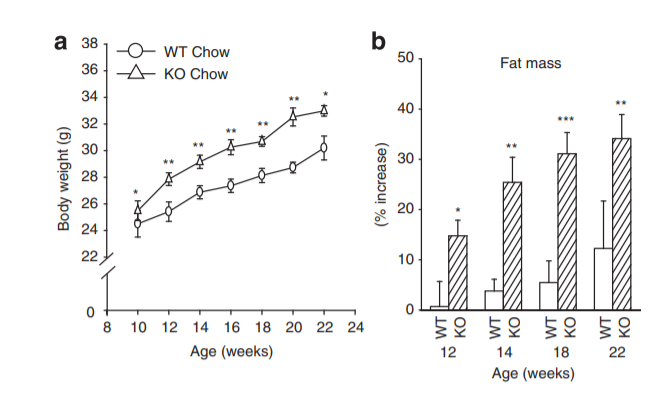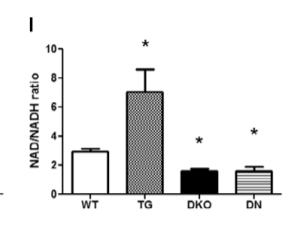Happy New Year! Fire In A Bottle (FIAB) is back!
I’m excited for the new year, I’ve got a great slate of upcoming posts, I’m planning a new “overview of FIAB concepts intended for newcomers and those who are less scientifically oriented. I’m going to continue working on the podcast and launch a TikTok channel!
The second half or 2021 got pretty nerdy on the molecular biology, so I have a series of articles about FIAB concepts having effects in the real world. There is going to be great stuff this year! But first, a little more molecular biology. This one isn’t that hard. These two papers really help build the support base around that idea that obesity is caused by mitochondrial reductive stress which is in turn caused by lack of mitochondrial ROS production.
Lack of mitochondrial ROS causes obesity
The paper “Deficiency in the NADPH oxidase 4 predisposes towards diet-induced obesity” buries the lead.1 The title should simply be “Deficiency in the NADPH oxidase 4 predisposes towards obesity”. It is known that certain high fat diet formulations will cause obesity in mice and this is what the phrase “diet-induced obesity” means. But mice lacking NADPH oxidase 4 (Nox4) get fat on a regular, lo-fat “chow” mouse diet. This is much more interesting than the fact that lack of Nox4 makes diet-induced obesity worse.

Nox4 is a mitochondrial enzyme that makes superoxide (ROS) from NADPH, the reduced form of NADP+. If you’ve been reading the blog, you’ll know that mitochondrial ROS production initiates a thermogenic cycle that regenerates NAD+, alleviating reductive stress and increasing metabolic rate. This is all thanks to the magic of superoxide.
Much of the blog focuses around the saturation level of fats and how they affect succinate dehydrogenase activity levels, which ultimately control the amount of mitochondrial superoxide production.
But another way to generate mitochondrial ROS (mitoROS?) is the enzyme Nox4, which simply takes the electron being carried by NADPH and creates a superoxide molecule. If you can’t generate mitoROS, you get fat. Even if you’re a mouse on a lo-fat chow diet.
More Proof That ROS Alleviates Reductive Stress
This paper2 didn’t look at reductive stress due to Nox4, but this one does. They actually create a mouse line which overexpresses NOX4 and a mouse line with a dominant negative version of Nox4. The first line has LOTS of Nox4 activity and the second live has very little. Predictably, the first line of mice have a very HIGH NAD+/NADH ratio and the second line has a very LOW NAD+/NADH ratio – reductive stress. Because lack of mitoROS creates reductive stress and makes you fat.

The cells lacking Nox4 activity showed clear reductive stress.
How can I generate more mitochondiral ROS?
One way to do it is with Succinade. Succinade is primarily made of succinate, which targets the activity level of succinate dehydrogenase. Succinate dehydrogenase is the main producer of mitochondrial ROS and therefore the main recycler of NAD+. I have argued that a primary cause of obesity is the lack of succinate dehydrogenase activity,.
Succinade tastes like lemonade for astronauts and will increase your overall succinate dehydrogenase actvivity level.
- 1.Li Y, Mouche S, Sajic T, et al. Deficiency in the NADPH oxidase 4 predisposes towards diet-induced obesity. Int J Obes. Published online March 20, 2012:1503-1513. doi:10.1038/ijo.2011.279
- 2.Yu Q, Lee CF, Wang W, et al. Elimination of NADPH Oxidase Activity Promotes Reductive Stress and Sensitizes the Heart to Ischemic Injury. JAHA. Published online January 27, 2014. doi:10.1161/jaha.113.000555

Brad, this study has me confused in the context of succinate and weight management, can you help me interpret?
https://www.nature.com/articles/s41396-018-0068-2
I wouldn’t look too closely, it’s an observational study that’s looking at blood metabolites and talks a lot about heart disease. A bunch of the participants were fat, diabetic, and taking metformin. It’s much more worthwhile to learn about intracellular mechanisms than some blood markers of the metabolically degenerate
Has anyone here taken succinate (without changing anything else) and found themselves losing weight ?
Also, has anyone there taken succinate (without changing anything else) and found themselves not losing weight ?
I took succinade for a bit but found myself with weird inflammation, but i think i might try it again…
i’ve been taking berberine and resveratrol until i learn more, and i haven’t gained OR LOST any weight, but my stomach got HUGE with bloating and i’m getting hernias, so i’m scared and just looked up if berberine causes bloating and listed as ‘rare’ side effects of berberine was ‘bloating and severe abdominal pain’… so i threw out my bottle and glugged some pepto bismol and now i’m sitting here kind of ticked off
all i’m eating right now is eggs and salad, so i knew it wasn’t the food
Berberine has a long list of receptor modifying activity. Pertaining to your comment it is an alpha galactosidase inhibitor. The diabetic prescription drug Acarbose is the poster child for this action. You can look it up on google to understand. Basically it prevents the small gut breakdown of many complex carbs. That leaves undigested food for bacteria further along the gut and subsequent gas bloating, and per drug monograph “anal leakage” But it does suppress your blood sugar. Other actions are ACE inhibition, 5 alpha reductase inhibition, PCSK9 inhibition, platelet aggregation inhibition, thrombin inhibition, AMPK activation, to name a few.
My cursory reading of literature on nox4 is that it does significantly raise mito ROS. However the context of these papers is not obesity or weight loss. Mostly warnings are of pathogenic conditions due to oxidative stress.
Caveat emptor
I took Alpha Lipoic Acid in the morning and most of a bag of Succinade. I was also taking berberine, astaxanthin, and Resveratrol.
The ALA made my pee smell. And the Succinade was helping me calorie restrict because I drank it before meals, and I just didn’t want to eat after. Then I got this crazy breakout on my forehead. I’m in my mid 40’s, I don’t get zits, much less this magnitude.
So I did a wash out. Went back to my standard supplements and discontinued all the rest. Been about a month now. The plan is on Monday (1/17) to start back the ALA and the succinade. Someone suggested mixing it with orange juice, I’m gonna try that. I will not be adding back the berberine, astaxanthin, and resveratrol. I’m hoping the breakout doesn’t return and the weight loss does.
I’ll def. report back my results.
Brad, do you know this? Superoxide is influeced by static electromagnetic field (sBE) and this can treat insulin resistance and T2D in mouse. Very interesting study.
“Our studies show that sBE therapy, which
can be fully automated, represents an entirely noninvasive
means to ameliorate insulin resistance through an interaction
with endogenous paramagnetic molecules (e.g., O2-) and
through the adaptive restoration of healthy redox homeostatic
mechanisms (e.g., GSH/GSSG). Thus, the findings presented
here identify a novel physiological effect of magnetostatic and
electrostatic fields that may be exploited for the automated
long-term, noninvasive management of T2D and potentially
other redox-related conditions.”
https://pubmed.ncbi.nlm.nih.gov/33264599/